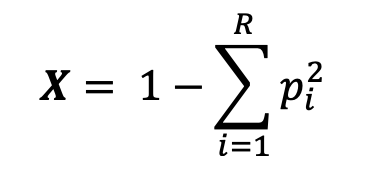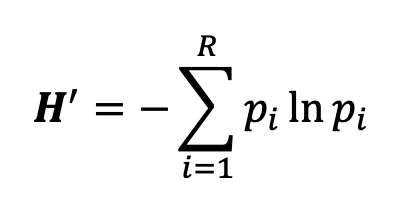MSCI345 Biodiversity and Classification
5.0(1)
5.0(1)
Card Sorting
1/60
Earn XP
Description and Tags
Study Analytics
Name | Mastery | Learn | Test | Matching | Spaced |
|---|
No study sessions yet.
61 Terms
1
New cards
Biodiversity
the variety of organisms that live in a particular location or habitat.
2
New cards
ecosystem services
More diverse ecosystems are better at providing “ ” to humans; things provided by nature that we often take for granted but would be very hard-pressed to produce on our own if nature wasn’t doing it for us.
3
New cards
economy
More diverse ecosystems are better at supporting the global “ “.
4
New cards
new resources
More diverse ecosystems offer more opportunities to discover “ “
5
New cards
resilient
More diverse ecosystems are more “ “ to disturbance
6
New cards
diversity index
a number that attempts to quantify diversity in some way.
7
New cards
Species Richness
(R) the number of species in a particular habitat, area, or biological community.
8
New cards
Evenness
refers to how even the proportions of each species are.
9
New cards
Gini-Simpson Diversity Index
When this diversity formula is applied to biodiversity, R represents the number of different species present in the community of interest (i.e., the richness), and pi represents the probability (on a scale from 0 to 1) of getting species “i” when you randomly pick an individual organism from that community. You can also think of pi as representing the proportion of the individuals made up by species i, because the probability is equal to the proportion.

10
New cards
Shannon-Wiener Diversity Index
a measure of how hard it is to predict what species you’ll get if you randomly select one individual out of an ecosystem or community in which you already know how many of each species are present.

11
New cards
1\.3 million
Over “ “ species on earth have already been described and assigned unique species names.
12
New cards
8 million and 10 million
Reasonable estimates put the total number of living species (including species that have not yet been discovered or named) at something between “ “ !
13
New cards
World Register of Marine Species
The largest, most comprehensive, international effort to catalog all marine life species; It currently lists over 240,000 known marine species.
14
New cards
taxon
simply a named group or category of organisms.
15
New cards
Scala Naturae
In this system, everything in the world, whether natural or supernatural, was arranged in a linear fashion with God at the very top and minerals at the very bottom.
16
New cards
Domain, Kingdom, Phylum, Class, Order, Family, Genus, Species
Do Kings Play Chess On Fine Green Silk?
17
New cards
binomial nomenclature
assigns to each species, living or extinct, a unique 2-part name
18
New cards
genus
refers to a taxonomic group containing a relatively small number of very similar species
19
New cards
specific epithet
identifies the species within the genus
20
New cards
capitalized
The first letter of every genus name is __always__ “ “ .
21
New cards
first letter of the genus
Only the “ “ name is capitalized; nothing else in the genus or specific epithet is ever capitalized, even if the specific epithet is based on a proper noun, such as a person’s name or a place.
22
New cards
italicized, underline
The entire scientific name should be “ “ . If you are hand-writing it or otherwise can’t italicize, then you should “ “ the name.
23
New cards
dissimilar
Genus names cannot be reused for “ “ taxa.
24
New cards
unique, reused
The specific epithet must be “ “ within a genus, but it may be “ “ for species in different genera (the plural of genus).
25
New cards
first letter, once
In publications, it is common to abbreviate scientific names by using only the “ “ of the genus name after the full scientific name has already been given at least “ “ prior to the abbreviation in that publication.
26
New cards
sp., spp.
When the genus is known, but the species isn’t known (or doesn’t matter), it’s common to use the genus name followed by the abbreviation “ ” or “ ”
27
New cards
Potential ways to define a species
* Nominalistic species concept
* Typological species concept
* Morphological species concept
* Biological species concept
* Phylogenetic species concept
* Recognition species concept
* Phenetic species concept
* Ecological species concept
* Genetic species concept
* Typological species concept
* Morphological species concept
* Biological species concept
* Phylogenetic species concept
* Recognition species concept
* Phenetic species concept
* Ecological species concept
* Genetic species concept
28
New cards
Phylogenetic tree
represent our best estimates as to how new species formed from this process of repeated speciation events, starting with that ancient ancestral cell and following all the splits and branches from way back then to the present day.
29
New cards
Cladistics
a particular approach to generating phylogenetic trees and classifying groups of organisms based on hypotheses about their evolutionary history.
30
New cards
cladogram
a particular type representing the hypothesized evolutionary relationships among some groups of organisms.
31
New cards
testable
Like other hypotheses, cladograms are designed to be “ '“.
32
New cards
how long ago
Cladograms attempt to describe which taxa are most closely related, but they do not attempt to represent “ “ groups diverged.
33
New cards
Monophyletic
describes a taxonomic group that includes an ancestral form and ALL of its descendants and nothing else
34
New cards
Clade
Same thing as a monophyletic group. Birds are a “ “
35
New cards
Cladogenesis
the formation of a new clade through speciation.
36
New cards
Polyphyletic
describes a taxon that fails to include the most recent common ancestor of the group’s other members.
37
New cards
Paraphyletic
describes a taxon that does include the most recent common ancestor of all the organisms in the group, but is missing one or more descendants of that common ancestor.
38
New cards
Synapomorphy
a shared, derived, characteristic that unites a clade. It’s a feature that first appeared in the most recent common ancestor of a group, then got passed down to the other members of the group.
39
New cards
Convergent evolution
Sometimes characters that are shared between two species but were NOT present in the common ancestor can mislead a scientist into thinking that two species are more closely related than they actually are.
40
New cards
Secondary loss of synapomorphies
loss of characters that otherwise unite a group.
41
New cards
Sessile Organisms
organisms that live attached to rocks or other (usually) stationary objects, so they can’t move from one place to another
42
New cards
Motile Organisms
These are organisms that can move around; the opposite of sessile.
43
New cards
Plankton
aquatic or marine organisms that cannot outswim typical water currents in areas where they live. They are therefore at the mercy of those currents, and get swept along wherever the currents take them.
44
New cards
Nekton
aquatic or marine animals that can outswim typical current speeds; are free to go more-or-less wherever they want, regardless of which direction the currents are flowing.
45
New cards
Pleuston
organisms living right at the air-water interface on the surface of a water body.
46
New cards
Benthos
Organisms that live on the bottom of the ocean
47
New cards
Benthic organisms
organisms that live on the bottom of the ocean; they are part of the benthos.
48
New cards
Demersal Organisms
These are motile organisms that live in close association with the bottom of the ocean (or another water body), but are not in direct contact with the bottom all the time.
49
New cards
Pelagic Organisms
These organisms live most or all of their life in the open ocean far from land. They may live mostly above the ocean surface (e.g., albatrosses and some other marine birds), on the ocean surface, or below the ocean surface, but they are not closely associated with land or the seafloor.
50
New cards
Autotroph
organisms derive their energy from sunlight or inorganic chemicals. They are also known as Primary Producers.
51
New cards
Photoautotrophs
organisms are autotrophs that derive their energy from sunlight through photosynthesis.
52
New cards
Chemoautotrophs
These organisms derive their energy directly from chemical reactions involving inorganic chemicals, such as hydrogen sulfide.
53
New cards
Heterotroph
organisms that get their energy by eating other organisms.
54
New cards
Herbivores
animals that eat plants, algae, or other non-animal organisms for food.
55
New cards
Predators
eat living prey. The term usually is limited to animals that eat other animals, but some people consider herbivores to be a subset of this group.
56
New cards
Scavengers
feed on the remains of dead organisms
57
New cards
Parasites
feed on the tissues or body fluids of other living organisms in a way that does not kill the host quickly.
58
New cards
Detritivores
feed on detritus, which is a general term for little bits of scrap organic matter, such as tiny bits of poop, plant fiber, or mucus, that originally came from other organisms.
59
New cards
Suspension feeders
feed on food particles (including whole organisms) suspended in the water column
60
New cards
Filter feeders
a subset of suspension feeders that capture suspended particles by passing water through a mesh or screen that traps any particles that are too large to fit through the holes in the mesh or screen.
61
New cards
Deposit feeders
feed on organic material that has settled onto surfaces or is buried in sediment.